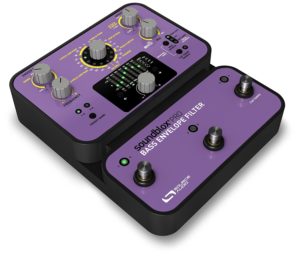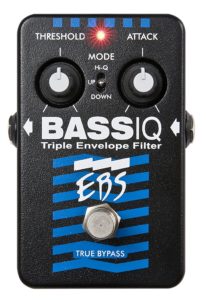Are you looking for the best bass envelope filter? Then, you’re in the right place.

Playing bass is about providing the “bottom end” and building a foundation for the rest of the instruments. At least, that’s the standard view for this vital piece of the musical puzzle.
But a quick look at the progression of bass instruments shows this original task has changed through the years.
Before electricity took music to another level, allowing performers to reach thousands of fans instead of a handful, a bass instrument provided a frequency and flavor few listeners noticed.
The audience was more likely to focus on “lead” instruments such as the violin, piano, etc. The bass line was louder when creative individuals such as Leo Fender, Les Paul, and others amplified guitar sounds. However, things didn’t change much in terms of gaining the attention of the listener.
Top 3 Best Bass Envelope Filters:
| Image | Model | Price |
|---|---|---|
 | MXR Bass Envelope Filter Effect Pedal (Top Pick) | Check Price |
 | Source Audio SA143 Bass Envelope Filter Pedal | Check Price |
 | EBS Bass IQ Analog Triple Bass Envelope Filter Pedal | Check Price |
MXR Bass Envelope Filter Effect Pedal (Editor’s Choice)
The MXR Bass Envelope Filter Effect Pedal delivers classic analog envelope filter performance with user-friendly design and construction. Low-end punch remains when you dial in the amount of filter you need, using Effect and Dry controls.
Sensitivity and attack are great, as is the true bypass, which preserves your tone. But, as with other top-shelf products in this line, funk is the name of the game.
You’ll like most about the MXR versatility, maintaining the desired low end with Dry and FX controls. Other controls give you extreme or mild effects.
This unit will operate on 9v battery power, though performance will probably be best with the AC unit. It’s lighter than some bass filter pedals at about 14 ounces.
Pros
- Sweet spots
- True bypass
Cons
- Settings are a bit limited
Source Audio SA143 Soundblox Pro Bass Envelope Filter
When you’re looking for the right bass envelope filter (or any new equipment) for your specific sound, you should pay close attention to what other players say.
The Source Audio SA143 Soundblox Pro Bass Envelope Filter deserves high marks for its versatility and because players can find the unique sound, they’re looking for. According to information from the manufacturer, this unit delivers 22 filter sounds, including “2 Pole Low Pass, 4 Pole Low Pass, Single Peak, Triple Peak & Notch, as well as Phasers.”
Other features include Wet/Dry knob with exceptional low-end preservation called “Lo-Retain.” The SA143 also has four modulation sources – envelope, LFO, expression pedal, and Hot Hand. This filter follows the previous edition, the Soundblox BEF.
You can modify settings with several control options, such as positive/negative filter sweeps, sweep range, attack speed, decay speed, and frequency range.
Three footswitches give the bassist six presets customized, with a Tap Tempo LFO option for one of the footswitches. The 1.1-pound filter unit requires four AA batteries, which are included.
While this top-end filter equipment will take some time to get used to, it will deliver great sound from first use. Take some time to tweak and adjust, and you’ll be amazed at the changes you get. There are lots of variables available.
Pros
- Versatile, variable sounds
- Onboard equalizer for a variety
- Easy to dial in sound
Cons
- It takes time to learn all the possibilities
EBS Bass IQ-Analog Triple Bass Envelope Filter Pedal
This filter unit is marketed as having true bypass and durable construction, and it delivers. As with other leading units, it’s triggered by your notes, with great response and some great funk.
You’ll be able to produce classic wah sounds automatically, choose the funkadelic sound, or find a unique sound to suit your ear.
Threshold and attack controls, plus three modes – Hi-Q, Up, Down – make the EBS Bass IQ-Analog Triple Bass Filter Pedal quite versatile. True bypass technique and more headroom give you extra space. Simultaneously, you’ll also appreciate improved sensitivity, easy-to-use dial-in analog circuitry, lower noise, and excellent dynamics for sound variety.
Bassists will enjoy experimenting with the IQ-Analog unit, achieving tight and funky, excellent auto-wah and up-wah. In addition, the EBS works well with active basses and passive basses.
You’ll appreciate the results from this unit, along with the analog warmth. It produces fine sound with slap technique.
Pros
- Three modes
- Sensitivity of adjustment
- Low Noise
Cons
- Could use more frequency and level control
Buyer’s Guide: How to Find the Best Bass Envelope Filters
What If There Was No Bass Line?
Unfortunately, the majority of listeners aren’t conscious of the bass line. However, if it were missing altogether, the music probably wouldn’t have the same effect.
A couple of years ago, one writer suggested that, contrary to popular opinion, bassists are very important to a band or any other musical group. The bass line provides a necessary background, a rhythm that people feel as much as they hear.
Think in terms of what part of the music you tap your feet to or tap your fingers to. For example, studies show people notice changes in rhythm in the bass register more readily than when the melody line changes.
It seems the human brain is more suited to following the rhythm and feel of music if it’s in the lower tones. So, bass is necessary. Without it, music wouldn’t be complete.
With this essential information in mind, you can begin to appreciate the changes that have taken place since the original acoustic/stand-up bass provided the necessary low end for orchestras several centuries ago.
In the 21st century, imaginative players seek ways to enhance the bass sound while holding on to that depth every music aficionado appreciates.
Bass Is Not Just Bass
Nuance in bass sounds? It’s been quite acceptable, even celebrated in recent decades. However, when the subject is envelope filtering, there are a couple of ways to do it.
Bass players have used a manual wah pedal for years, rocking the foot back and forth to produce the unique sound, though some players decide against using this sound at all.
The other way to produce a great-but-different sound is to use a bass envelope filter pedal as part of the input line. Since this equipment takes the manual pedal and the foot action, it’s sometimes called the auto-wah.
However, bass’s best envelope filters provide a pop that many players seek for slap bass and funk. Get the right filter pedal, and you will have a sound you can’t produce with manual wah, no matter how fast your foot is.
The pedal unit uses a peaking filter, which amplifies a specific frequency and cuts off others. The quickness of electronics responds faster than the musician can move the pedal, delivering unique effects.
A bassist can produce consistent sound with practice, shaping sound beyond what a manual pedal can produce.
Final Thoughts on Bass and Envelope Filters
When you take the manual operation of the old-style wah pedal out of the equation, you step into the new world of highly interactive equipment with the bass envelope filter pedal.
Because the response dynamics are quick and efficient, you can change sounds with minimal adjustments to your playing technique.
That’s why some players love using these units when they need an excellent slap sound or when they’re reproducing the bass sounds made famous by such greats as Herbie Hancock, George Clinton, and others.
It does take some practice before you feel entirely comfortable with the auto-wah performance. However, you can achieve a consistent sound as you use the filter pedal more.
Flea uses this method to perfection with “Falling Into Grace” with the Red Hot Chili Peppers. The Band used a more traditional wah sound with “Cripple Creek.” However, it would certainly be possible to reproduce this or enhance it with auto-wah.
As you shop for your bass envelope filter pedal, look for sensitivity control features to adjust the input level. That helps match that level for the follower and other circuitry. Depth of filter sweep is essential, as is control for filter resonance, multiple filters, and Up/Down filters.
As with any other quality music equipment, you should view this particular unit as an investment. Some players will spend the money on a high-end pedal and use it for one or two songs.
Of course, this will depend on what your group is trying to present to listeners. However, you’ll probably find your fellow musicians thinking adding the bass envelope filter is a fantastic idea, primarily when you’ve used it enough to get just the right sound.